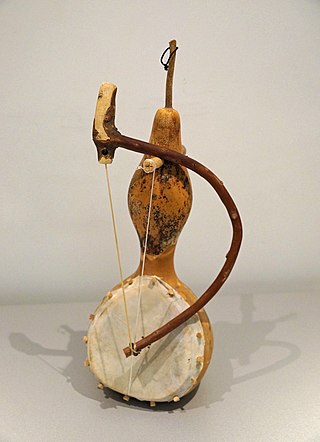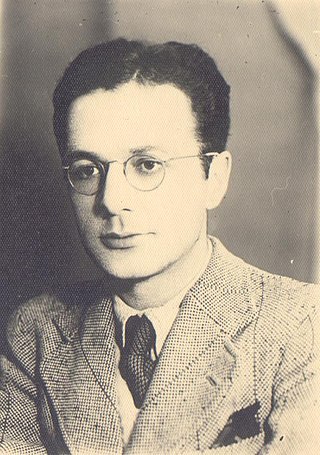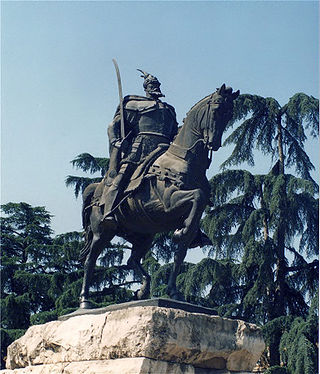Related Research Articles
American folklore encompasses the folklore that has evolved in the present-day United States mostly since the European colonization of the Americas. It also contains folklore that dates back to the Pre-Columbian era.
In Māori mythology, taniwha are large supernatural beings that live in deep pools in rivers, dark caves, or in the sea, especially in places with dangerous currents or deceptive breakers . They may be considered highly respected kaitiaki of people and places, or in some traditions as dangerous, predatory beings, which for example would kidnap women to have as wives.

The music of Albania is associated with the country of Albania and Albanian communities. Music has a long tradition in the country and is known for its regional diversity, from the Ghegs in the North to the Tosks in the South. It is an integral part of the national identity, strongly influenced by the country's long and turbulent history, which forced Albanians to protect their culture from their overlords by living in rural and remote mountains.
Đerzelez Alija or Gjergj Elez Alia is a legendary character found in the epic poetry and literature of Bosnia and Herzegovina, Gora, Kosovo and northern Albania. The legendary character is believed to have been a popular Muslim epic hero of the Bosnian Krajina from the end of the 15th century. He is one of the well known legendary heroes and a symbol of brotherly loyalty to both the Bosniaks and Albanians.

Albanian folk beliefs and mythological stories comprise the beliefs expressed in the customs, rituals, myths, legends and tales of the Albanian people. The elements of Albanian mythology are of ancient Paleo-Balkanic origin and almost all of them are pagan. Albanian folklore evolved over the centuries in a relatively isolated tribal culture and society. Albanian folk tales and legends have been orally transmitted down the generations and are still very much alive in the mountainous regions of Albania, Kosovo, western North Macedonia, Montenegro and South Serbia and among the Arbëreshë in Italy and the Arvanites in Greece.
Zana is an Albanian mythological figure usually associated with mountains, springs and streams, forests, vegetation and animals, human vital energy and sometimes destiny. Zana is thought to have been originally a pre-Roman deity, and an Illyrian goddess equivalent of the Ancient Greek Artemis and Roman Diana.

Dhimitër Pasko was a well-known Albanian writer, literary critic and translator. Along with Ernest Koliqi he is considered as the founder of modern Albanian prose; in Albanian literature his pen name for which he gained fame was Mitrush Kuteli.
The drangùe is a semi-human winged divine hero in Albanian mythology and folklore, associated with weather and storms. Babies destined to become drangue are born with their heads covered in caul and with two or sometimes four wings under their arms. The drangue hold supernatural powers, especially in the wings and arms. A drangùe is made invulnerable by the singular conjunction produced at his birth, and can die only if this conjunction is repeated once again. The main goal of the drangue is to fight the kulshedra in legendary battles. He uses meteoric stones, lightning-swords, thunderbolts, piles of trees and rocks to defeat the kulshedra and to protect mankind from storms, fire, floods and other natural disasters caused by her destructive power. Heavy thunderstorms are thought to be the result of their battles. The drangue and their myth are extensively and accurately portrayed in the Albanian folk tale "The Boy who was Brother to the Drague".

Vajtim or Gjëmë is the dirge or lamentation of the dead in the Albanian custom by a group of men or a woman or a group of women. Cries have now become extinct both in the Islamic and Christian Albanian Population, except in some parts Northern Albania and Kosovo as well as in parts of North Macedonia such as Zajas and Upper Reka, where they exist in a very diminished form.

The Kângë Kreshnikësh are the traditional songs of the heroic legendary cycle of Albanian epic poetry. They are the product of Albanian culture and folklore orally transmitted down the generations by the Albanian rhapsodes (lahutarë) who perform them singing to the accompaniment of the lahutë. The Albanian traditional singing of epic verse from memory is one of the last survivors of its kind in modern Europe, and the last survivor of the Balkan traditions. The poems of the cycle belong to the heroic genre, reflecting the legends that portray and glorify the heroic deeds of the warriors of indefinable old times. The epic poetry about past warriors is an Indo-European tradition shared with South Slavs, but also with other heroic cultures such as those of early Greece, classical India, early medieval England and medieval Germany.

Albanian epic poetry is a form of epic poetry created by the Albanian people. It consists of a longstanding oral tradition still very much alive. A good number of Albanian epic singers can be found today in Kosovo and northern Albania, and some also in Montenegro. The Albanian traditional singing of epic verse from memory is one of the last survivors of its kind in modern Europe, and the last survivor of the Balkan traditions.

Dhimitër Shuteriqi was an Albanian scholar, literary historian, and writer. He participated in the anti-fascist National Liberation Movement. After the war, he was a member of the People's Assembly and one of the founders and later president of the Albanian League of Writers and Artists. In addition to a series of books and novels, he has published numerous volumes of textbooks, especially those on the History of Albanian Literature for high schools.

The Myth of Skanderbeg is one of the main constitutive myths of Albanian nationalism. In the late nineteenth century during the Albanian struggle and the Albanian National Awakening, Skanderbeg became a symbol for the Albanians and he was turned into a national Albanian hero and myth.
The lubia or ljubi is a water and storm demon in Albanian mythology and folklore, usually depicted as a huge multi-headed female serpentine dragon similar to the kulshedra. In Southern Albanian beliefs, she is a storm deity. She is also referred to as ‘mother lubia’.She is known for her disturbingly huge appetite and eerie personality. Both of which characteristics are based off the fierce impression the sea gives you on stormy weather. The native people used hyperbole and made a vile creature out of the bad weather conditions.
The Ora is an Albanian mythological figure that every human possesses from birth, associated with human destiny and fate. The essential function of the ora is to maintain the order of the universe and to enforce its laws.
Kosovan folk music is rich with rare and unique elements. Kosovo's folklore claims roots in the 6th–5th centuries BC.
Uran Butka is an Albanian writer, historian and politician. The son of Safet Butka and grandson of Sali Butka, he is one of the founding members of the National Association of Political Prisoners. Butka also served as a member of the Albanian Parliament from 1992 to 1997.

Zojz is a sky and lightning god in Albanian pagan mythology. Regarded as the chief god and the highest of all gods, traces of his worship survived in northern Albania until the early 20th century, and in some forms still continue today.
Gazmend Çitaku is an Albanian Montenegrin photographer, publisher, and librarian. Born on December 4, 1970, in Skenderaj, Kosovo, he lives and works in Ulcinj, Montenegro. He belongs to the Universum Academy of Switzerland, Bashkimit të Krijuesve Shqiptarë në Mal të Zi, and the Qendrës Mediterane të Fotografisë dhe Asociacionit Ulqini.

Gjeto Basho Muji or simply Muji is a legendary Albanian warrior from "Songs of the Heroes" Albanian folktale ballads. It is revered as one of the most important legendary heroes of Albanian folklore in Northern Albania, Kosovo, and among the Malësor Albanians of Montenegro.
References
- 1 2 3 Robert Elsie; Janice Mathie-Heck (2004). Songs of the Frontier Warriors. Bolchazy-Carducci Publishers. pp. 367–. ISBN 978-0-86516-412-3.
- ↑ Kuteli, Mitrush (1987). Tregime të moçme shqiptare. Tirana: Naim Frasheri. Retrieved 2010-07-08.